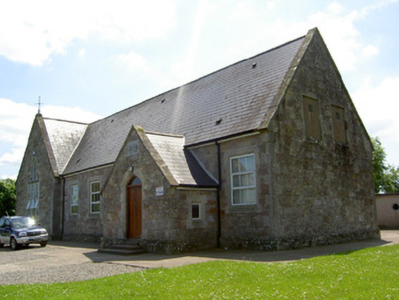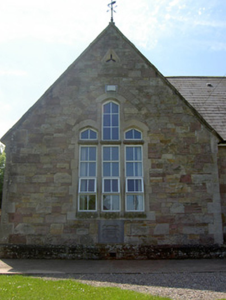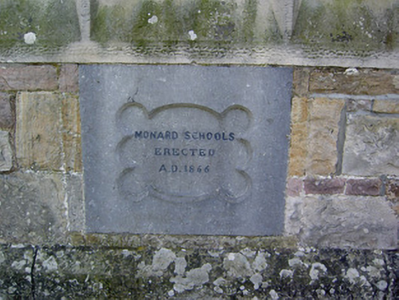Survey Data
Reg No
22205807
Rating
Regional
Categories of Special Interest
Architectural, Artistic, Historical, Social
Original Use
School
In Use As
School
Date
1865 - 1870
Coordinates
184816, 139922
Date Recorded
08/06/2005
Date Updated
--/--/--
Description
Detached L-plan Tudor Revival style five-bay single-storey primary school, dated 1866, having now disused attic storey, slightly advanced gable-fronted bay to end of façade, gable-fronted entrance porches to other end of façade and to south-east elevation, and having flat-roofed single-storey extension with chimneystack to rear. Pitched artificial slate roofs with replacement uPVC rainwater goods, having cast-iron weather vane to gable-front and limestone coping to gable ends and to porches. Snecked sandstone walls, partly rendered to rear, with cut limestone quoins, plinth, date plaque and 'Girls' and 'Boys' plaques to entrance porches, and having block-and-start cut and tooled limestone surrounds to openings. Pointed trefoil opening over triple pointed segmental lancet windows to gable-front, latter with pointed retaining arch of alternately coloured voussoirs. Square-headed elsewhere to mainly once-mullioned two-light windows, now single windows. All windows have replacement uPVC frames. Four-centered arch door openings with chamfered sandstone surrounds, timber battened doors with overlights, and accessed by steps. Roughly coursed dressed limestone boundary walls, incorporating stiles and having steel gates.
Appraisal
This pleasant Tudor Revival style schoolhouse was built by local landlord Lord Stanley in 1866, in a then prominent location on the Stanley estate. The building originally incorporated the schoolmaster's living quarters in the now disused attic storey. Separate boys' and girls' entrance porches, a common feature in the nineteenth century, are still present. Interestingly Lord Stanley, while Chief Secretary for Ireland, was instrumental in establishing the national school system in Ireland, and much later in his career became British Prime Minister. It displays good-quality stonecraft, especially in its openings and plaques. In spite of modern alterations this building, which is still a functioning schoolhouse, retains its original mid-nineteenth century form and character.





